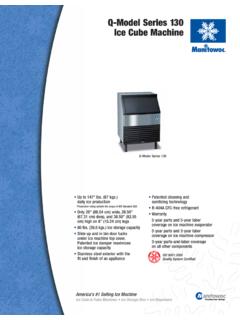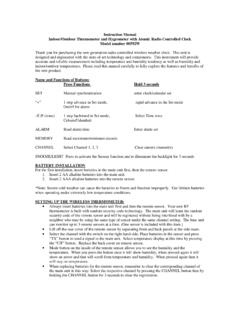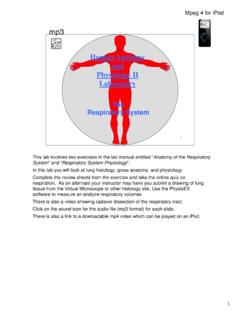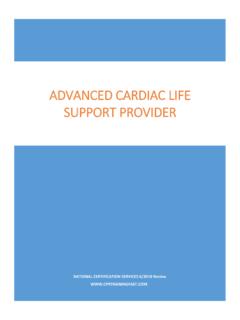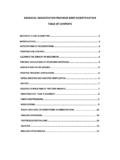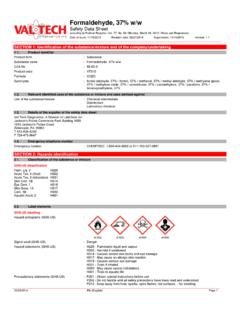Transcription of MATERIAL SAFETY DATA SHEET - National Trade …
1 MATERIAL SAFETY data SHEETICE MACHINE CLEANER ID: MI0895 Revised: 04-26-2006 Replaces: 01-15-2003 1. PRODUCT AND COMPANY IDENTIFICATIONP roduct Name:ICE MACHINE CLEANER ID:MI0895 Synonyms:O-99725 CAS Number:MIXTUREC hemical Family:Acid DetergentFormula:Proprietary InformationDISTRIBUTED BY: EMERGENCY RESPONSE NUMBERS:Manitowoc Ice, Hour Emergency #: (920) 682-01612110 South 26th St. CHEMTREC Emergency #: (800) 424-9300 Manitowoc, WI 54220(920) BY: HYDRITE CHEMICAL CO. 2. HAZARDS IDENTIFICATIONEMERGENCY OVERVIEW: DANGER! CORROSIVE. Causes severe burns to eyes, skin, and respiratory tract. Harmful or fatal if swallowed. Harmful if inhaled. Reacts with most metals to form explosive/flammable hydrogen :Clear. :No HEALTH EFFECTSR outes Of Exposure: Eyes. Ingestion. Inhalation. Organs: Eyes. Skin. Respiratory System. Gastrointestinal Tract.
2 Circulatory System. Peripheral Nervous System. Contact: CORROSIVE-Causes severe irritation and burns. Small amounts may cause: tissue destruction. permanent eye damage. blindness. redness. Contact: CORROSIVE-Causes severe irritation and burns. Contact may not produce an immediate burning sensation, delaying awareness that contact has occurred. Death may result from burns which extend over large portions of the Absorption: No absorption hazard expected under normal use. Page: 1 of 7 MATERIAL SAFETY data SHEETICE MACHINE CLEANER ID: MI0895 Revised: 04-26-2006 Replaces: 01-15-2003 Inhalation: CORROSIVE-Causes severe irritation and burns. Vapors or mists may damage: upper respiratory tract. May cause: tearing. coughing. sneezing. salivation. labored breathing. shortness of breath. fluid in lungs. Excessive exposure may cause: chemical : CORROSIVE-Causes severe irritation and burns.
3 May cause damage to the: mouth. throat. esophagus. stomach. digestive tract. May cause: nausea. vomiting. diarrhea. abdominal pain. chest pain. shortness of breath. seizures. circulatory shock. unconsciousness. death. increase blood calcium levels. Erosion of teeth is possible. Large amounts may cause:Medical Conditions Aggravated By Exposure To Product: Skin disorders. Respiratory system disorders. Eye disorders. Kidney disorders. Hypercalcemia. Blood disorders. Dehydration. Hormonal : None Information: This product does not contain greater than of the known or potential carcinogens listed in NTP, IARC, or Environmental Effects: See Section 12. 3. COMPOSITION/INFORMATION ON INGREDIENTS ComponentCAS NumberOSHA Hazard% by Acid7664-38-2 YES< 40 %Citric Acid77-92-9 YES< 10 % 4. FIRST-AID MEASURESEye Contact: Immediately flush eyes with plenty of water for at least 15 minutes while holding eyelids open.
4 Tilt head to avoid contaminating unaffected eye. Get immediate medical attention. Skin Contact: Immediately flush skin with plenty of water for at least 15 minutes while removing contaminated clothing and shoes. Get medical attention immediately. Do not reuse clothing and shoes until cleaned. Do not apply oils or ointments unless ordered by the : Remove to fresh air. If breathing is difficult, administer oxygen. If not breathing, give artificial respiration, preferably mouth-to-mouth. GET MEDICAL ATTENTION IMMEDIATELY. Ingestion: If fully conscious, drink a quart of water. DO NOT induce vomiting. CALL A PHYSICIAN IMMEDIATELY. If unconscious or in convulsions, take immediately to a hospital or a physician. NEVER induce vomiting or give anything by mouth to an unconscious victim. If vomiting occurs spontaneously, keep head below hips to prevent aspiration of liquid into the lungs.
5 Note to Physicians: The use of gastric lavage is controversial. The advantage of removal of acid must be weighted against the risk of perforation or bleeding. If a large amount of acid (> 1 ml/kg body weight) has been recently ingested, cautious gastric lavage is generally advised if the patient is alert and there is little risk of convulsions. Consultation with a gastroenterologist and/or surgeon is advised. Serious complications such as perforation or stricture of the esophagus may occur requiring care by specialists. Laryngeal edema may develop requiring intubation or : 2 of 7 MATERIAL SAFETY data SHEETICE MACHINE CLEANER ID: MI0895 Revised: 04-26-2006 Replaces: 01-15-2003 5. FIRE FIGHTING MEASURESE xtinguishing Media: For fires in area use appropriate media. For example: Water spray. Dry chemical. Carbon dioxide. Alcohol Fighting Methods: Evacuate area of unprotected personnel.
6 Wear protective clothing including NIOSH-approved self-contained breathing apparatus. Remain upwind of fire to avoid hazardous vapors and decomposition products. Use water spray to cool fire-exposed containers. Product generates heat upon addition of water, with possible spattering. Run-off from fire control may cause And Explosion Hazards: This product may react with certain metals to produce flammable Hydrogen Combustion Products: Phosphorous oxides. Carbon dioxide. Carbon monoxide. Aldehydes. Ketones. 6. ACCIDENTAL RELEASE MEASURESS pill Clean-Up Procedures: CORROSIVE MATERIAL . Evacuate unprotected personnel from area. Maintain adequate ventilation. Follow personal protective equipment recommendations found in Section 8. Never exceed any occupational exposure limit. Contain spill, place into drums for proper disposal. Carefully neutralize remaining residue with soda ash.
7 Exercise caution during neutralization as considerable heat may be generated. Flush neutralized spill with copious amounts of water. Avoid direct discharge to sewers and surface waters. Notify authorities if entry occurs. 7. HANDLING AND STORAGEH andling: Avoid contact with eyes, skin, and clothing. Use with adequate ventilation. Do not swallow. Avoid breathing vapors, mists, or dust. Do not eat, drink, or smoke in work area. Wash thoroughly after handling. Empty containers retain product residue (vapor, dust, or liquid) and can be dangerous. DO NOT pressurize, cut, weld, braze, solder, drill, grind, or expose such containers to heat, flame, sparks, static electricity, or other source of ignition. They may explode and cause injury or death. Storage: CORROSIVE MATERIAL . Store in a cool, well ventilated area, out of direct sunlight. Store in a dry location away from heat.
8 Keep away from incompatible materials. Keep containers tightly closed. Do not store in unlabeled or mislabeled containers. Do not freeze. 8. EXPOSURE CONTROLS/PERSONAL PROTECTION Exposure Guidelines:ComponentOSHA PELOSHA STEL/CACGIH TWAACGIH STEL/CPhosphoric Acid1 mg/m31 mg/m3+Not mg/m3+1 mg/m33 mg/m3 Citric AcidNot : 3 of 7 MATERIAL SAFETY data SHEETICE MACHINE CLEANER ID: MI0895 Revised: 04-26-2006 Replaces: 01-15-2003 Note: + Vacated 1989 OSHA PEL(s).Engineering Controls: Local exhaust ventilation, process enclosures, or other engineering controls are imperative when handling or using this product to avoid overexposure. Avoid creating dust or mist. Do not use in closed or confined spaces. Keep levels below exposure limits. To determine exposure levels, monitoring should be performed Protection: Wear chemical SAFETY goggles and a full face shield while handling this product.
9 Do not wear contact Protection: Prevent contact with this product. Wear gloves and protective clothing depending on condition of use. Protective gloves: Acid-proof. Gauntlet-type. Rubber (latex). Neoprene. Protection: Respiratory protection must be worn when handling this product. If exposure limits are exceeded, wear: NIOSH-Approved respirator. Acid gas cartridge. DO NOT exceed limits established by the respirator manufacturer. All respiratory protection programs must comply with OSHA 29 CFR and ANSI requirements and must be followed whenever workplace conditions require a respirator's Protective Equipment: Eye-wash station. SAFETY shower. Rubber apron. Chemical SAFETY shoes. Rubber boots. Protective Hygiene Conditions: Wash with soap and water before meal times and at the end of each work shift. Good manufacturing practices require gross amounts of any chemical be removed from skin as soon as practical, especially before eating or smoking.
10 9. PHYSICAL AND CHEMICAL PROPERTIESP hysical State: : Clear. : No Point (deg. F): Point (deg. F): Point (deg. F): Pressure (mm Hg): Vapor Density (air=1): in Water: CompletepH: < 2 (as is) Specific Gravity: @25C % Volatile (wt%): Rate (nBuAc = 1): VOC (wt%): (lbs/gal): : Flash Point: Explosion Limit: Explosion Limit: Temperature: No DataPage: 4 of 7 MATERIAL SAFETY data SHEETICE MACHINE CLEANER ID: MI0895 Revised: 04-26-2006 Replaces: 01-15-2003 10. STABILITY AND REACTIVITYS tability: Stable under normal To Avoid: Contact with water may cause violent reaction with evolution of heat. To dilute: Add product slowly to lukewarm water; not water to Materials: Metals. Strong oxidizing agents. Strong reducing agents. Sulfides. Sulfites. Bases. Fluorine. Sulfur trioxide. Phosphorous pentoxide. Sodium tetrahydroborate. Aldehydes.


